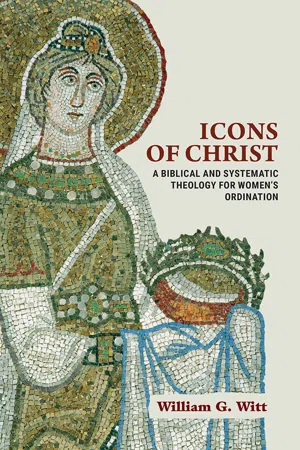
Icons of Christ
A Biblical and Systematic Theology for Women’s Ordination
- 447 pages
- English
- ePUB (mobile friendly)
- Available on iOS & Android
About this book
The pastoral office is one of the most critical in Christianity. Historically, however, Christians have not been able to agree on the precise nature and limits of that office. A specific area of contention has been the role of women in pastoral leadership. In recent decades, three broad types of arguments have been raised against women's ordination: nontheological (primarily cultural or political), Protestant, and Catholic. Reflecting their divergent understandings of the purpose of ordination, Protestant opponents of women's ordination tend to focus on issues of pastoral authority, while Catholic opponents highlight sacramental integrity. These positions are new developments and new theological stances, and thus no one in the current discussion can claim to be defending the church's historic position.
Icons of Christ addresses these voices of opposition, making a biblical and theological case for the ordination of women to the ministerial office of Word and Sacrament. William Witt argues that not only those in favor of, but also those opposed to, women's ordination embrace new theological positions in response to cultural changes of the modern era. Witt mounts a positive ecumenical argument for the ordination of women that touches on issues such as theological hermeneutics, relationships between men and women, Christology and discipleship, and the role of ordained clergy in leading the church in worship, among others.
Uniquely, Icons of Christ treats both Protestant and Catholic theological concerns at length, undertaking a robust engagement with biblical exegesis and biblical, historical, systematic, and liturgical theology. The book's theological approach is critically orthodox, evangelical, and catholic. Witt offers the church an ecumenical vision of ordination to the presbyterate as an office of Word and Sacrament that justifiably is open to both men and women. Most critically Witt reminds us that, as all Christians are baptized into the image of the crucified and risen Christ, and bear witness to Christ through lives of cruciform discipleship, so men and women both are called to serve as icons of Christ in service of the gospel.
Frequently asked questions
- Essential is ideal for learners and professionals who enjoy exploring a wide range of subjects. Access the Essential Library with 800,000+ trusted titles and best-sellers across business, personal growth, and the humanities. Includes unlimited reading time and Standard Read Aloud voice.
- Complete: Perfect for advanced learners and researchers needing full, unrestricted access. Unlock 1.4M+ books across hundreds of subjects, including academic and specialized titles. The Complete Plan also includes advanced features like Premium Read Aloud and Research Assistant.
Please note we cannot support devices running on iOS 13 and Android 7 or earlier. Learn more about using the app.
Information
Notes
1. Preliminaries
2. Non-theological Arguments against the Ordination of Women
Table of contents
- Cover
- Title Page
- Copyright Page
- Contents
- Preface
- Introduction
- Protestant Arguments
- Catholic Arguments
- The Ministry of Women in the New Testament
- Notes
- Bibliography
- Index